Yet again a small group boarded a train heading for Sheffield, this time to attend the Active Travel Summit that had been arranged by Cycle Sheffield. With a full day ahead the first presenter on stage was Councillor Julie Grocutt, describing the projects underway and the plans for further work to encourage active travel in Sheffield. The Sheaf Valley Cycle to Dore and Totley is one route being promoted but there are still issues that are causing concern with parts of the route. Responding to a question she indicated that her cycle routes into the city centre were not cycle friendly, having to negotiate busy arterial roads. Like many cities the provision of cycle routes seems to be something of a challenge which requires radical steps to changes, but will certainly have been done somewhere before.
Council officer Will Stewart responded to a question on the quality of road construction indicating that he has arranged to ride some of the city streets with the contractors so they gain a full appreciation of the challenges faced by people on bikes. An excellent demonstration of how to influence people, which raised questions in my mind why have the all the councillors not be taken for a bike ride around the city they represent and while at it take bus and taxi drivers on bikes to experience the feeling of being passed by a large vehicle at speed or close passed.
Jon Burke was not able to attend the summit, instead sent a video presentation. He described his approach to changing the environment of the borough of Hackney, removing parking, creating low traffic neighbourhoods, adding greenery to beautify public spaces and street furniture. Providing seating for elderly and infirm to sit and rest, places to meet and allow children to play in the public realm. Jon indicated that 70% of households in Hackney do not own a car, an amazing statistic when we live in a car dominated country where 78% of households have at least 1 car. Most of the car journeys in Hackney were people travelling through the borough, and his actions to reduce the ability to drive through residential areas has brought him into conflict with drivers. His efforts to reduce through traffic and ‘rat-running’ had resulted in numerous threats with one threatening to kill him, his family and burn their house down, just because this driver couldn’t drive his car where he wanted.
He said, “If you build roads, cars will fill them. There is no mechanism through the construction of roads to reduce the number of cars on those roads.” Society need to be clever in how the public realm is used, for the benefit of everyone, providing a safe spaces for people to move, meet and mingle. We must also be aware of people making egregious threats to individuals doing their job or representing a view, this is just not acceptable in a civilised society.

We enjoyed presentations from Sheffield Cycling 4 All, an organisation that runs inclusive all-ability cycling for any adult who can’t ride a 2-wheel bike due to disability or long-term health condition. Christine had been knocked off her bike, the injury had resulted in knee replacement and loss of confidence in riding her bike. She needed to exercise regularly to keep her joints mobile, Sheffield Cycling 4 All helped her with finding a trike which has allowed her to become mobile again. Jane had suffered osteoarthritis for a number of years which has gradually reduced her ability to get around. She found that a trike gave her the ability to get around, to ride in parks and paths in the countryside. They both complained that various forms of barriers prevented their trikes accessing many paths and parks. Also, trikes don’t handle well on broken, irregular, sloping and rutted surface, emphasising that good surfaces are important to people using trikes but also for those using other wheeled mobility devices.
The 2021 Census shows there are about 10 million disabled people in England and Wales (about the population of London), representing just under 20% of the population. Many of these people would benefit from improved infrastructure that would allow them to access facilities, as would many others.

Jenny Clark of Living Streets, Sheffield South West, presented a different perspective on the risks of children walking to school. Assessing the risks encountered on a routine walk to school using the Health and Safety Executive (HSE) guidance for assessing acceptable risks. Not surprisingly the analysis showed the risk as being ‘unacceptable’. The hierarchy of control identifies the actions necessary to reduce the risk, the first three are mostly ignored (elimination of risk, substitute the risk, control by isolating from people) and only consideration being applied to the last two controls; administrative control (training/schooling) and Personal Protective Equipment.

Society addresses the risk by lecturing children at school on road awareness and recommending that children wear brightly coloured and reflective clothing, meanwhile the most effective controls are only paid lip service. Many parent control the risk by driving their children to school, unfortunately increasing the risk to those children walking (Driving children to school account for 30% to 40% of all peak time car journeys).

Brian Deegan, Director of Inspections at Active Travel England, described some of the infrastructure issues that inspectors will be assessing. He described the ’15 critical issues’, infrastructure feature that are associated with collisions, describing each feature in some detail, explaining the problem to vulnerable road users and potential remediation. The audience sat engrossed by the comparative simple solutions to the critical issues.

Brian’s list of critical issues emphasised to me that the whole system has been designed to facilitate people in cars. Compelled by a culture that unconsciously believes that driving is ‘normal’ and the only way to travel, where people make decisions to prioritise the car. Brian and his colleagues have the opportunity to redress the situation to create an environment which allow everyone to use the public realm safely.
The last person to speak was Ed Clancy, South Yorkshire’s new Active Travel Commissioner. He had literally been in post for a few days so was still getting up to speed but saw his role as bringing parties together to facilitate improvements.
I came away from the summit enthused by all the optimistic presentations and discussions with like minded people. Sheffield is making changes, as we have seen, and there are plans for further development. Yet, there is much more to do before everyone can safely walk and cycle. Implementation of infrastructure is incredibly slow in England, Sheffield’s Grey to Green started 10 years ago and is no different to the glacial progress in the majority of other cities. Implementation of schemes must accelerate to progress the plans in a timely manner for everyones benefit. We have been shown the risks to our children yet we prevaricate while more suffer ill health, injury and even death, meanwhile the number of cars continue to increase.
Beyond the sanctuary of this active travel summit is a cultural acceptance that driving is ‘normal’ or even the ‘proper’ way to travel. The normalisation of driving, for even the shortest of journeys, is fundamental to car dominance in our society and results in people unconsciously making decisions that prioritise driving. The challenge we face is enabling people to see that there are choices in the way we travel which can have less impact on peoples lives and improve the environment.

